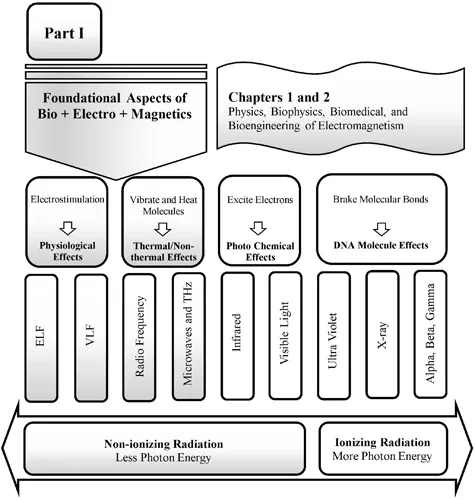
BioElectroMagnetics
Human Safety and Biomedical Applications
Riadh Habash
- 506 pages
- English
- ePUB (adapté aux mobiles)
- Disponible sur iOS et Android
BioElectroMagnetics
Human Safety and Biomedical Applications
Riadh Habash
À propos de ce livre
This book is an educational resource of evolving scientific knowledge in the area of bioelectromagnetics that may serve the interests of students and decision-makers, as well as society as a whole. It is distinguished by extensive descriptions of fundamental biophysical concepts and their relevance to human health. Reflecting the transdisciplinary approach from several different intellectual streams including physics, biology, epidemiology, medicine, environment, risk science, and engineering, the book is quite a venture into the battling studies to assess the latest research on health effects and biomedical applications of EM energy. This new edition of the book particularly looks at the potential threats from the emerging 5G wireless networks, which will deploy large numbers of low-powered smartphones, notebooks, tablets, radio access networks, and other transmitters.
Features
- Introduces necessary biophysical principles of EM fields in the context of their interaction with living systems.
-
- Strengthens understanding of cutting-edge research on several major areas in the broad area of bioelectromagnetics.
-
- Presents safety standards and guidelines for human exposure to EM fields.
-
- Discusses techniques that have been developed to ensure adequate EM-thermal dosimetry required for both health effects and biomedical applications.
-
- Provides insight into the determinants of EM health risk assessment and public concerns.
-
- Includes extensive reference list at the end of each chapter to enhance further study.
-
Riadh Habash is a special appointment professor and McLaughlin Research Chair in Electromagnetic Fields and Health at the University of Ottawa, Canada. He has been the recipient of many awards, including the National Wighton Fellowship Award, and has authored or co-authored over 90 research articles, six books, and five book chapters. His most recent books are Green Engineering in 2017 and Professional Practice in 2019 (CRC Press), with the remaining previous books targeting the area of bioelectromagnetics.
Foire aux questions
Informations
part one
Foundational Aspects of Bio + Electro + Magnetics

chapter 1
Foundations of electromagnetism
The hypothesis
1.1 Natural and artificial electromagnetic fields
1.1.1 Natural sources
1.1.2 Artificial sources
EM Source | Static | ELF/VLF | RFR |
Various natural sources | x | x | x |
Overhead power lines and underground cables | x | ||
Substation and converter stations | x | ||
Home appliances | x | x | x |
High voltage direct current (DC) lines | x | x | |
Photovoltaic arrays for power generation | x | x | |
Wind turbines | x | x | |
Transformers and power substations | x | x | |
Wiring and equipment in homes and workplaces | x | x | |
Electric floor heating systems | x | ||
Arc welders | x | x | |
RF sealers, induction heaters, and microwave ovens | x | x | |
Traction and rail systems | x | x | x |
Aircraft power system | x | x | x |
Broadcasting transmitters | x | ||
Smart electricity meters | x | x | |
Cellular and mobile services | x | x | |
Wi-Fi and Bluetooth devices | x | ||
Wireless sensor networks | x | ||
Wireless Gigabit | x | ||
Wireless chargers | x | ||
Electric vehicles | x | x | x |
RFID/EAS systems | x | x | |
Diathermy, hyperthermia, and ab... |